From Single Atoms to Engineered “Super-Atoms”: Interfacing Photons and Atoms in Free Space
Abstract
During the last decades the development of laser cooling and trapping has revolutionized the field of quantum optics. Now we master techniques to control the quantum properties of atoms and light, even at a single atom and single photon level. Understanding and controlling interactions of atoms and light both on the microscopic single particle and on the macroscopic collective levels, are two of the very active directions of the current research in this field. The goal is to engineer quantum systems with tailored properties designed for specific applications. One of the ambitious applications on this way is interfacing quantum information for quantum communication and quantum computing. We summarize here theoretical ideas and experimental methods for interfacing atom-based quantum memories with single flying photons.
1. Introduction
Single quantum objects such as atoms and photons have played an outstanding role in understanding the fundamental concepts of quantum world. Apart from the fundamental contribution to the development of quantum physics, they played a key role in the development of the concept of quantum information with its main building block a “qubit” [1–3]. Any quantum mechanical two-level system sufficiently isolated from the environment can potentially represent a qubit. Among such systems are trapped single ions, photons, quantum dots, neutral atoms, or any artificial atom-like systems. Atomic systems are very attractive since they are well understood and now routinely manipulated. Single atoms exhibit favorable properties for storing and processing quantum information. Their states, carrying qubits, can be well isolated from the environment, making them a good candidate for quantum memories [4]. On top of this, we have a well-developed universal set of tools, both for ions [3, 5, 6] and neutral atoms [7, 8], to controllably switch on and off interactions between atoms. This makes atomic systems an ideal candidate for the implementation of elementary quantum gates.
In the middle of quantum computing, one may need to transfer data from one place to another, and at the end of a quantum calculation the state of the atomic qubits should be read out. This is typically realized by forcing the atoms to emit photons, which then will be subsequently detected and analyzed. At the same time, single photons are natural candidates for long distance quantum communication. A combination of stationary qubits in atoms and flying qubits in photons, transmitted through optical fibers or free space, is expected to be an important ingredient in the achievement of the ambitious long term goals for quantum communication. Therefore high efficiency interfacing of single photons and atoms is the key challenge [9, 10].
Although photon emission from a single atom in vacuum is not directed, its directionality can be controlled by changing the properties of the electromagnetic vacuum surrounding the atom. The two extreme cases include surrounding the atom by a high finesse resonator [11] and superradiance effects in an atomic ensemble [12]. In the first case the resonator selects only one spatial mode of the electromagnetic vacuum available for the atom emission [13, 14]. In the last case, the atomic sample is free in space, but the collective interaction of all atoms with the available spatial vacuum modes sets the emission directionality.
It is the aim of this paper to describe the state-of-the-art in the interfacing single photons with free space single atoms and engineered atom-like systems “superatoms” both from the theoretical and the experimental perspectives. In particular, in Section 2 we concentrate on two types of processes: one optically excited atom decays to a ground state with the emission of exactly one photon and a single photon absorption by a single atom. Section 3 is devoted to engineering free space atomic ensemble systems, which behave quantum mechanically as a single quantum objects but have enough degrees of freedom to tune its quantum properties.
2. Single Atoms
The question of interfacing single photons and single atoms is the main goal of this section. This interface consists of three processes: emission of a single photon by an atom, transmission of the emitted photon to another atom, and absorption of this photon. This question is of interest from the applied side as well as from the fundamental point of view. To formulate the requirements for a practical realization of these processes we start with a theoretical analysis. This allows us to optimize these processes in the ideal case situation before adapting them to real atoms.
2.1. Modelling Single Free Atom-Single Photon Interface
2.1.1. Photon Emission
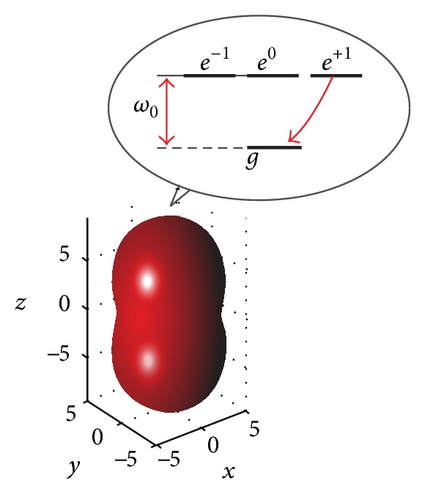

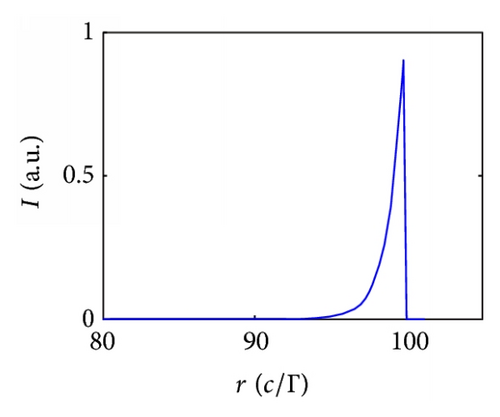
2.1.2. Photon Transmission
We concentrate now on the spatial pattern of the emitted electromagnetic field wave packet, described by the first two lines of (18). This field pattern has no pronounced directionality and the intensity drops down with the separation from the atom. In order to transfer this emitted photon wave packet to an another distant atom, we have to convert the dipole mode of the emitted electromagnetic field into a propagating Gaussian mode. These modes can propagate over large distances in space or through optical fibers.
This problem of conversion of the dipole radiation pattern to a Gaussian has been studied in details in the context of the limits of tight light focusing [23–26]. The key observation is that polarization effects play a key role in going to the limit of focusing. Such specially crafted beam at the point of tightest focusing possesses more structure than just a spot size. In particular, it contains polarization singularities [27], which resemble dipole emission pattern or a “dipole wave.” For example, the polarization structure of the tightly focused Gaussian radially polarized light beam (such beam is obtained, e.g., by a superposition of two Hermite-Gaussian modes TEM01 and TEM10 with orthogonal polarizations [24]) resembles the field pattern of a |e0〉 − |g〉 atomic dipole transition [24]. It has a torus-like structure, typical for a dipole emission pattern (see Figure 1(b)), with the polarization directed perpendicularly to the corresponding k-vectors of the propagating field. Therefore, in a time reversed process, a photon emitted by a single atom can be converted to a radially polarized Gaussian beam.
Although quite high conversion can be efficiently reached with a lens, it does not collect light from the full 4π spatial angle. A novel beam focusing method using a deep parabolic method promises to overcome this last drawback [28, 29]. Sending radially polarized Gaussian beam into this mirror (see Figure 2) creates in the mirror focus 3D field, which resembles the dipole emission pattern on the |e0〉-|g〉 transition. Thus, in contrast to a lens, such mirror allows covering almost all 4π of the spatial angle in the focus. In the reversed process, the radiated field from an atom, placed in the focus of this parabolic mirror, is almost completely collected and transformed onto a superposition of the Hermite-Gaussian field modes. Generally, depending on the dipole moment alignment, the superposition of the modes will change, but the Gaussian modes propagate naturally in space. Thus using this method, the photon emitted by an atom can be converted from a dipole mode to a Gaussian mode. The photon in this mode can propagate to another distant atom. Finally, mode of this photon can be converted back to a dipole mode to match the spatial absorption mode of the target atom. The last process is inverse to the emission and should be possible based on time reversal arguments [24, 30].

2.1.3. Photon Absorption
Application of the time reverse argument for photon absorption requires that the incoming to the atom photon has to match the time reversed state originated from spontaneous decay process. This implies that both the spatial pattern of the incoming photon and the temporal pattern match those of the absorbing atom. Only in this case, an atom initially prepared in the ground state will efficiently be excited by absorbing this incoming photon [24, 30, 31]. In the previous section we discussed the spatial matching requirement. Therefore we concentrate now on the temporal matching of the incoming photon.
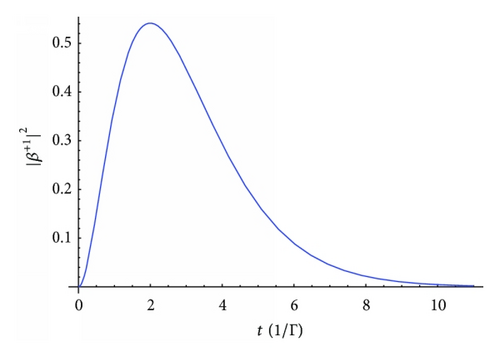
Conceptually, there are two widely accepted strategies for temporal matching of the incoming photon to an atom. In the first scheme we adjust the phases of the photon to match the target atom. The phases of the modes of the emitted photon Ex. (22) have to be transformed to exactly match the phases necessary for the absorption by the target atom equation (21). Mathematically, the difference between these equations is in complex conjugation, provided that the time independent positions of the atoms can be properly selected. Physically, we have to phase conjugate the photon wave packet coming from the source atom, which produces a time reversed photon wave packet, before absorbing this photon with the target atom. This process of complex conjugation was analyzed in detail in the context of “undoing” aberrations in imaging or beam transmission [32–37]. In the heart of the phase conjugation process is a nonlinear process of four-wave mixing or utilization of nonlinear refraction [37–40]. However it was shown that this nonlinear process results in addition of excess noise in the time-reversed beam [30, 41, 42]. Although this is not a serious issue for imaging purposes, it is a serious obstacle in the case single photon processes.
In an alternative scheme, we tailor the atom emission and absorption processes so that the corresponding wave-functions for the emitted and absorbed photons have the same mode distributions, in contrast to (21) and (22) of the first scheme, which have different phases. For tuning the photon mode distribution we need an additional degree of freedom in the atom. This is achieved by extending the atomic level structure from a two-level as depicted in the inset of Figure 1 to a ladder-like structure (Figure 4). In this configuration the atomic population initially in a metastable state |f〉 is fed by an external time dependent laser light with the coupling ΩL(t) to a decaying state |e+1〉. The frequency of the laser light ωL and its detuning from the |f〉-|e+1〉-transition are δ = ωfe − ωL. This modification of the atomic level structure does not change the spatial mode profile of the emitted photon [17, 43] but allows controlling the amplitudes and phases of the photon field distribution. In particular, it allows controlling the temporal dynamics of the decay process from the atom. In order to see this, we look at the atomic level dynamics in this configuration.
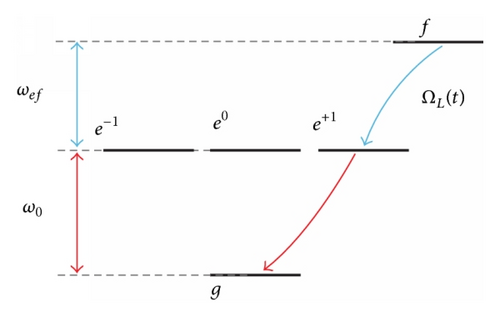
Although there is no general analytic solution of these equations for an arbitrary coupling ΩL(t), we can already qualitatively see that the photon modes equation (17), which are proportional to the probability amplitude β+1, can arbitrarily be controlled. In particular, it is possible to generate symmetric in time wave-packets, which can be directly sent to the target atom eliminating the need for time reversal of the emitted photon. Consequently, based on the time reversal argument [24, 30], the target atom will fully absorb such incoming photon, provided that ΩL(t) coupling between |e+1〉 and |f〉 levels is properly timed. A detailed study of the performance of this photon temporal control method has been performed in the context of atom-cavity and multiatom collective processes [17, 45–48]. See as well Section 3 for more numerical examples.
2.2. Experimental Techniques
The starting point of our theoretical analysis was the Hamiltonian of the atom-photon system in the form (31). In particular, it requires a single atom localized at one point is space and emitting without any recoil (otherwise the spectrum of the emitted photon will be affected due to the Doppler effect). Practically such atomic system can be a single atomic ion localized in a Paul ion-trap or a single neutral atom localized in an optical tweezer.
2.2.1. Single Atom Trapping
Historically, the first trapped single atomic particle was a barium ion in a Paul trap by Neuhauser and collaborators at the end of the seventies [49]. Although there is no configuration of static charges, in which a positive charge always experiences a force returning to the center, it can be achieved by suitably changing charges in time. This effectively creates a 3D static conservative potential for an ion. The idea behind a Paul ion trap is to use metal electrodes and apply the corresponding time varying voltages to them to create the configuration of electric charges, that is necessary for ion trapping [50]. The depth of a Paul trap for single atomic ions can be orders of magnitude larger than a room temperature, so it can trap even a thermal ion (we use a temperature conversion from the trap depth TPaul = UPaul/kB with kB being the Boltzmann constant). Since the Paul trap creates an effective conservative potential, an ion should be produced inside the trap to stay confined. For this purpose neutral atoms are sent into the ion trap, where they are subsequently ionized. Most of the modern quantum optics experiments use atoms from the second column of the periodic table of elements. These atoms have two valence electrons. The first electron can be resonantly removed by laser light in the process of photoionization, leaving the charged atomic ion with one valence electron. Therefore such ions have a relatively simple level structure as shown in Figure 5 for Ca atoms. Such resonant photoionization for ion trap loading was pioneered by Lucas, Kjaergaard, and collaborators in 2000 [44, 51].
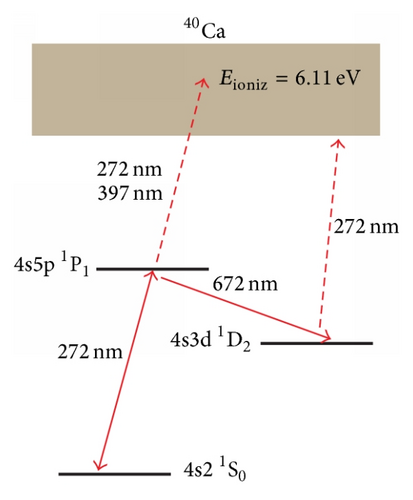
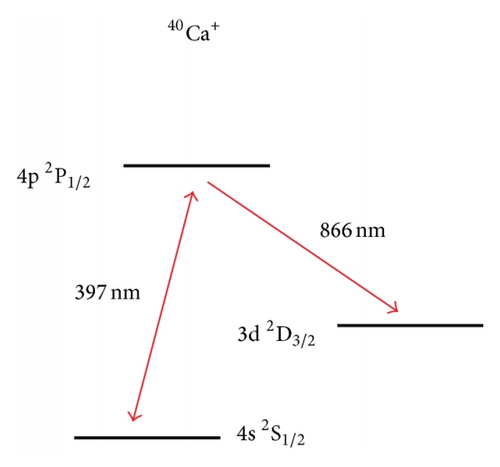
An experimental alternative to a trapped atomic ion is a single trapped neutral atom. A cloud of neutral atoms can be cooled and localized in space using radiation pressure forces [52]. An optical dipole trap is a typical tool for modern single neutral atoms experiments. A two-level atom in the ground state placed in a laser beam, which is red-detuned relative to the atomic transition, experiences a light shift of the ground state towards lower energy. Since this shift is proportional to the light intensity at the position of the atom, the atom experiences a potential minimum at the center of the Gaussian laser beam; see Figure 6. Therefore a focused laser beam can be used as tweezers for neutral atoms [53, 54]. This optical dipole force at the focus of the laser beam creates an effective 3D conservative potential, that is, “trapping volume.” Such optical dipole forces acting on neutral atoms in optical tweezers are orders of magnitude smaller than Coulomb forces acting on atomic ions in Paul traps. The depth of an optical dipole trap Tdipole = Udipole/kB is typically only several milli kelvin [55]. In order to load atoms into such trap, they should be precooled in a magneto optical trap, which utilizes the combination of position dependent Zeeman shifts with Doppler cooling [56]. Moreover, since an optical dipole trap creates a conservative potential, atoms should be cooled inside the dipole trap.
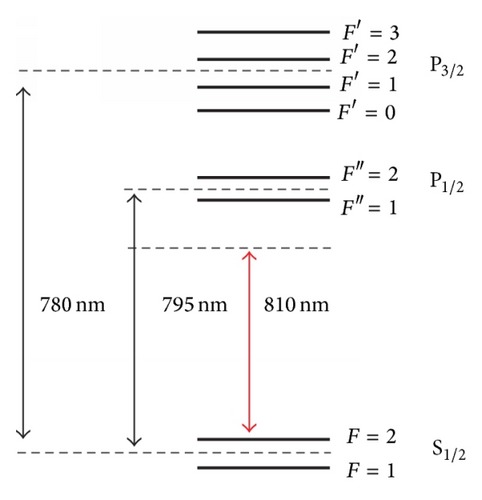
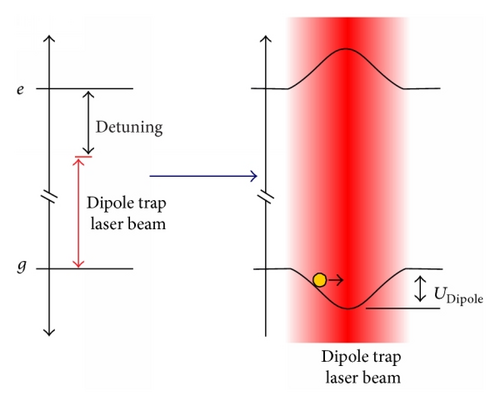
There are two main strategies of loading single atoms in an optical dipole trap. In the first method pioneered in the group of Frese and collaborators [53, 57], one starts with a magneto optical trap (MOT), which is specially designed for cooling and trapping single neutral atoms by carefully tuning the trap loading rate and trapped atom loss rate [58–60]. This single atom is then reloaded into an optical dipole trap by overlapping these traps for some time, resulting in cooling and therefore trapping of the single atom inside the conservative potential of the dipole trap. This reloading can be performed with nearly unit efficiency [57]. In the second method pioneered by Schlosser and collaborators [61], one starts with a multiatom MOT, which is then overlapped with an optical dipole trap. Due to the overlap, atoms are continuously loaded into the conservative potential of the optical tweezers. If the trapping volume of the tweezers is small enough, two and more loaded atoms experience light induced collisions during this overlap and are expelled from the optical dipole trap. In contrast, a single atom is laser cooled and remains trapped. This process of trapping exactly a single atom and expelling multiple atoms from optical tweezers is called collisional blockade. In this case, switching off the MOT results is expelling of the atomic cloud of atoms outside the optical dipole trap and trapping exactly one atom inside the conservative potential of the optical tweezers. In recent years further modifications of this single atom loading method were developed. They optimized single atom loading efficiency by tuning the energy distribution between the atoms during the light induced collisions inside the optical tweezers [62].
So far most of the experiments with single neutral atoms were performed with the atoms from the first column of the periodic table of elements. These atoms have one valence electron and therefore have a relatively simple level structure as shown in Figure 6 for the case of 87Rb. According to the dipole electric transition rules the atom excited to the state P3/2 and hyperfine level can only decay to the state S1/2 |F = 2, mF = 2〉. This closed transition is used for Doppler cooling and photon emission-absorption. All alkali atoms possess a similar closed transition and therefore are suitable for Doppler laser cooling. Recent advances have been made in laser cooling and trapping of alkaline earth or rare-earth atoms, for example, strontium, ytterbium, and so forth. These elements have two valence electrons and generally have a much richer manifold of electronic levels. Despite the increased complexity, these atoms have experimental advantages. Such atoms have closed transitions, which are prerequisites for laser cooling of atoms, and a very simple ground state manigold, which is suitable for studying experimentally basic single atom, single photon interactions described in the previous section. For example, the ground state of 88Sr atom has only one substate, since its nuclear spin is zero [63, 64]. Therefore the transition is suitable for single photon emission-absorption of any desired polarization, in contrast to the circularly polarized photons in the case of closed transitions of alkali atoms.
For all experiments relevant to this topic, trapping an atomic particle is followed by Doppler laser cooling and consequent sideband cooling of an atomic ion in a Paul trap or a neutral atom in an optical dipole trap [65–72]. This allows a dramatic improve in atom localization and eventually reaches a regime necessary for recoilless photon emission and absorption, which is called Lamb-Dicke regime [65, 73]. A part of the photons scattered by the atoms during the Doppler cooling stage is collected for atom detection and imaging. A typical signature of a single atom signal is the presence of discrete steps in the photon count rate; see Figure 7. Preparation of a single atom is the starting point for single photon emission experiments.
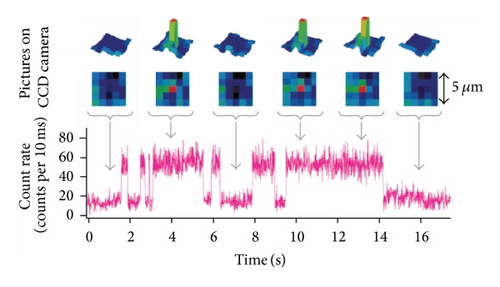
2.2.2. Single Photon Emission
We first identify the relevant atomic levels. Although the electronic energy level structure of different trapped atoms is different, they have one common feature: there is a closed transition, which can be identified with the levels |g〉 and |eν〉 from Section 2.1. For example, for 87Rb neutral atom these levels are S1/2|F = 2, mF = 2〉 (|g〉) and (|e+1〉) or S1/2|F = −2, mF = −2〉 (|g〉) and (|e−1〉). For 40Ca ion these levels to a high precision (as there is a small percentage probability to decay to a metastable states D3/2 and D5/2 [74, 75]) are S1/2 | J = 1/2, mJ = 1/2〉 (|g〉) and (|e1〉) or S1/2 | J = −1/2, mJ = −1/2〉 (|g〉) and (|e−1〉). Note that all these transitions involve circularly polarized photons. This feature is common for all atoms typically used for single atom experiments so far, that is, alkali neutral atoms and atomic ions from the second column of the periodic table of elements, because of the Zeeman degeneracy of the ground state. Neutral alkaline earth or rare-earth atoms [64] and doubly charged ions [29], for example, 174Yb, possess isotopes with zero nuclear spin and therefore with a single ground state. Such atoms have closed transitions even for linearly polarized photons and therefore represent a true two-level system, which was at the center of our discussion in Section 2.1. After isolating a single cold atom, photon emission experiments can be further carried out.
Spontaneous emission of a single photon from a single atom naturally occurs with 100% probability. The temporal profile of the emitted photon intensity has an exponential shape in equation (18). Using an additional metastable state properly coupled to the decaying level, the temporal profile of the emitted photon can be controlled at will, as we discussed in Section 2.1.3. This was experimentally demonstrated with single ions and single neutral atoms in the context of cavity quantum electrodynamics [47, 48, 76].
The spatial emission profile from a free space atom depends strongly on the type of the coupling. As we have analyzed in Section 2.1, efficient collection of light with a dipole pattern is a highly nontrivial task. Therefore a lot of experimental work with free space single neutral atoms and ions has been carried out with a simplified collection method using a high numerical aperture lens [77–81]. As we have discussed in Section 2.1.2, the collection profile of a lens does not correspond precisely to the dipole emission profile. Therefore only a part of the emitted electromagnetic field is collected and further transmitted to the detection optics. For example, in [77] a lens with NA = 0.7 was used and the measured overall collection efficiency was reported to be ca. 0.6%, which includes all technical imperfections.
Although the technical design of each single photon emission experiment is unique, there are certain experimental steps which are common to all experiments: single atom trapping, single atom excitation, and photon emission, collection, and analysis. To illustrate these steps, we look in more detail onto the experiment from [77]. The experiment starts with the overlap of a MOT of 87Rb with a tightly focused laser beam of an optical dipole trap. Due to the process of collisional blockade, exactly one atom is loaded into the conservative potential of the optical tweezers. Atoms in the optical tweezers at this stage are continuously cooled with the MOT light and the corresponding fluorescence from the atom in the tweezers is continuously collected. Due to the collisional blockade only two distinct fluorescence levels are possible, that is, corresponding to the background counts and corresponding to fluorescence from exactly one atom (Figure 7). In the last case the MOT is switched off, and exactly one atom is left in the optical tweezers. At the second step the atom is excited with σ+ polarized resonant laser light pulses at 780.2 nm on the cycling transition from the electronic state S1/2 | F = 2, mF = 2〉 to . The power and length of each pulse is tuned to perform a π-Rabi rotation on this transition and prepare the atom with almost 100% efficiency in the excited state . The length of the pulses 4 ns is chosen to be much shorter than the natural lifetime 26 ns of this excited state. According to the dipole selection rules, this state can only decay to S1/2 | F = 2, mF = 2〉. This closed transition thus works as a two-level atom emitting circularly polarized photons, corresponding to Figure 1(a). The emitted photon is then finally collected and analyzed using single photon counting detectors.
In this experiment the probability to emit a single photon per excitation pulse was 0.981, whereas the probability of emitting two photons was 0.019. Thus this experimental setup provides a deterministic source of single photons. The typical figure of merit, showing the presence of truly single photons, is the quality of the photon antibunching for zero delay, measured by recording g(2)(t) correlation function [82]. After an atom has emitted a photon, it needs some time to get excited again and be ready for the emission of the following photon, therefore resulting in ideally zero coincidence of detecting two photons with no delay; see Figure 8. In order to collect such a histogram many repetitions of the experiment are necessary. At same time, the collection efficiency of emitted photons is ca. 0.6% due to the mismatch of spatial modes of the dipole emitter and the lens imaging system. Therefore the experiment has to be repeated even more times, in order to collect enough photons for the characterization of the performance of the experiment.
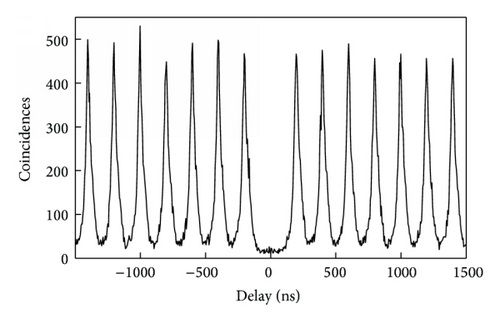
2.2.3. Single Photon Absorption
The inverse process of coupling a single emitted photon emitted by the first atom to another free space single atom requires a precise and efficient control of three quantum objects in one experiment: The first atom should be prepared in the proper excited state to emit a photon. The emitted photon should be efficiently collected, transmitted, and delivered in the proper mode to the target atom. The target atom should be initialized in the proper state for the following efficient photon absorption. Precise control of each of the quantum objects in one experiment is currently a challenging experimental task [86]. In order to simplify the process of experimental optimization of each of these steps, current experimental study is focused on the last step only, the process of photon absorption by a single atom.
According to the analysis in Section 2.1.3, both spatial and temporal modes of the incoming photon and of the absorbing free space atom should be matched to reach full absorption of the single photon by the atom. Since the combined effect of spatial and temporal modes matching is important for the efficient photon-atom coupling, it is useful to have a method to experimentally characterize and optimize each of these effects separately [83].
The main body of the experimental work in this direction has looked at different effects of photon-atom interaction characterizing elastic light scattering of dispersively interacting weak laser light with a single atom [85–90, 92, 95, 96]. In all these experiments a laser light beam is focused onto a single trapped atom using a high numerical aperture lens. For weak light fields the population of the atomic excited state is negligible, and therefore the elastic scattering effects contain information about the strength of the photon-atom interaction. The interaction of a single atom dipole with the light results in its phase shift relative to the incoming light. The transmitted and reflected light is the superposition of the incoming and the scattered waves. If the accumulated phase shift is large enough, this results in a destructive interference of the incoming and phase shifted light in the forward direction, which is observed as light extinction or reflection from a single atom. The back-scattered or reflected light is then directly collected with the focusing lens [92]. The transmitted light is collected using an additional high numerical aperture lens in front of the focusing lens. The phase shift of the transmitted light is directly measured using Mach-Zehnder interferometer [88] or using heterodyne techniques [90]. In the ideal case of the lens covering exactly half of the solid angle and the light in the focus resembling the dipole pattern matching the atom, a full extinction is theoretically expected [97]. The strongest so far experimentally observed extinction is of the order of 20% of the optimum [85–89]; see Table 1.
| Reference and experimental system | Year | Extinction | Reflection | Phase shift | Absorption | Coupling efficiency |
|---|---|---|---|---|---|---|
|
1987 | ≤0.1% | — | — | — | — |
|
2007 | 12% | — | — | — | — |
|
2008 | 22% | — | — | — | Estimated ca. 7% |
|
2008 | 10% | — | — | — | — |
|
2009 | — | — | 1° | — | — |
|
2010 | 1.4% | — | — | — | — |
|
2011 | 19% | — | 3° | — | — |
|
2011 | — | — | — | 0.03% | — |
|
2011 | — | 0.17% | — | — | — |
|
2013 | — | — | — | — | 3% |
|
2014 | — | — | — | — | 7.2% |
All the above listed measurements of the photon-atom coupling efficiency are based on the negligible population in the excited state. The nonvanishing excited state population results in incoherent scattering and deterioration of the phase sensitive interference effects. To account for the incoherent effects, one has to independently determine the excited state population.
Therefore there is another group of experiments, where the inelastic interaction of light with single atoms is explicitly studied, with the main aim to bring a single atom into its excited state with a single photon [93, 98]. According to Section 2.1.3 not only the spatial, but also the temporal modes of the incoming photon and of the absorbing free space atom should be matched. For a two-level system the incoming photon should have exponentially rising temporal shape [31]. Since the temporal shaping of a single photon packet is by itself a challenging experimental task, most of the experimental work is done with synthesized photons instead of using two identical atoms using one as a single photon emitter and the other one as a single photon absorber. The photon packets are created by attenuating laser pulses to few or less than one photon per pulse after temporally shaping them using a combination of an acousto-optic and an electro-optic modulators [93, 98]. An alternative method to attenuated laser beams is a single photon creation in a parametric down conversion. Here a pair of entangled photons is created. Due to the entanglement of the photons, spectrally filtering one the photons of the pair using an optical resonator with a bandwidth matching the atomic transition changes the temporal property of the second photon of the pair sent to the absorbing atom [91]. In this work the efficiency of the process was quantified by the photon absorption probability; see Table 1. Although this quantity is experimentally straightforward to measure, it contains only combined information about the spatial and temporal modes matching.
Experimentally, the coupling efficiency in [94] was measured in the following way. First, one ion is produced by isotope selectively photoionizing a neutral 174Yb atom [100] inside an ion trap situated in the focus of a parabolic mirror; see Figure 2 [101]. Then the ion is Doppler cooled on the transition at 369.5 nm, which is used as a two-level system in this experiment. After the preparation of the two-level system, it is then illuminated with the laser light of a proper polarization through the parabolic mirror, which provides the dipole mode conversion. During this time the atom scatters light in the dipole mode, which is then collected and converted through the parabolic mirror back to the propagating Gaussian mode. This light is collected during 100 ms. Varying the power of the illuminating beam using an acousto-optic modulator and correcting for the background scattering each step, the resulting saturation curve is obtained; see Figure 9. The curve is saturated at the excited level population of 1/2, corresponding to the scattering rate of Rsc = Γ/2. This gives a natural scaling for the excited state population. The power necessary to create the excited state population of 1/4 is extracted from the graph. Finally, comparing this number to the corresponding theoretically expected value P1/4 and including the experimental parameters allow calculating the free atom coupling efficiency according to (29), describing the quality of the spatial mode matching, independently on the temporal mode.
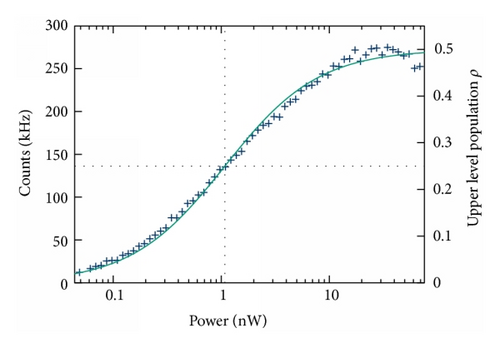
2.3. Conclusions
In this section we theoretically formulated the problem of efficiently interfacing single free space atoms and single photons. The first main challenge arises from the fact that the natural single atom emission pattern has a dipolar spatial dependence, whereas the propagating in space photons is in a Gaussian mode. An efficient conversion between these photon modes is the main key to the first challenge. Among the technical solutions for the mode conversion are high numerical aperture lenses and parabolic mirrors. The last ones promise the most efficient conversion efficiency. In order to characterize the quality of the spatial mode matching a quantity coupling efficiency is used. An extensive discussion about the connection of this coupling efficiency to the well known strong coupling regime in the context of cavity QED is given in [83]. Note that, in contrast to the cavity QED case, where the field mode structure around the atom is changed and so the atomic emission pattern is changed, the field mode converter for the free atom does not change the field mode structure and density.
The second main challenge is the temporal mode matching of the incoming photon. A spontaneously emitted photon has an exponentially decaying profile. At the same time, a two-level atom requires an exponentially rising temporal pulse for efficient photon absorption. Therefore either we stay with two-level atoms, as they are easier to treat theoretically but require a technique for reshaping temporal profiles of single photons, or we extend a pure two-level system. This allows us to add a tool for modulating the temporal emission and absorption profiles to match one of the absorbing atom. Although there exist techniques for temporal light pulse shaping, they may result in too much excessive noise at the single photon level. Therefore the modulation of the emission pattern using an extra atom level is technically more promising.
Finally, we went through the state-of-the-art experiments on single free atom, photon interaction to demonstrate how the necessary ingredients of theoretical ideas can experimentally be realized, and where the challenges on the experimental side are.
3. “Superatoms”
Although we have several theoretical ideas of improving single atom, single photon interfacing, their laboratory implementation and scaling to many atom-photon interface nodes may be technically challenging. We concentrate now on an alternative complementary idea of using atomic ensembles instead single atoms itself. Our goal is to engineer an atomic quantum object, a “superatom,” which can emit and absorb single photons with high efficiency.
Tuning the collective interaction of all atoms in the ensemble with the available photon vacuum modes allows controlling emission-absorption directionality [102]. In the classical case this corresponds to an interference from an array of dipole antennas. In the quantum case this is connected to a superradiance effect. On the other hand, tuning the strong interactions between the atoms excited to Rydberg states allows treating multiatomic system as an artificial atom with only one excitation. This behavior is known as Rydberg blockade.
3.1. Superradiance
3.1.1. Modelling Superradiance
The collective interaction of light with ensembles of absorbers and scatterers has been an active field of study since the early days of electromagnetism, while collective phenomena in spontaneous emission received wide attention with the pioneering work on Dicke superradiance from population inverted samples [103]. Early studies of collective emission from ensembles with few excitations [15, 104–108] (see also [109] and references therein) have been followed by a recent flourishing of analyses [17, 18, 43, 110–117]. Although this collective interaction is by itself an interesting question from the fundamental interest point of view, here we focus on the applied side, the controlled emission of a single photon and its reabsorption by small atomic samples.
To release a photon from the system, similar to Section 2.1, we use a classical laser field with the Rabi frequency ΩL to drive the atomic f-state amplitude into an optically excited state e+1, with a strong dipole coupling to the ground state g. The system now acts as an antenna array for dipole radiation on the transition e-g, and this is the cause of the desired directionality of the emitted light. As indicated in Figure 10, the initially populated states may be extremal Zeeman sublevels with well defined polarization selection rules, and the photon emitted on the e-g transition may be σ+ polarized with respect to the atomic quantization axis. In contrast to the single atom case, this field, however, may be reabsorbed by another atom located in an arbitrary direction from the emitter, and, here, the expansion of the field on polarization components permits excitation with selection rules Δm = 0, ±1. To describe the many-atom emission, we thus have to include other Zeeman sublevels than the ones initially populated. This motivates the model depicted in Figure 10, with unique states g and f, and three excited states e0 and e±1, corresponding to a J = 0-J = 1 optical transition. This configuration is the simplest extension of a two-level model atom that allows us to fully take into account the polarization of the emitted and reabsorbed light as well as the resulting dipole-dipole interactions between the atoms.
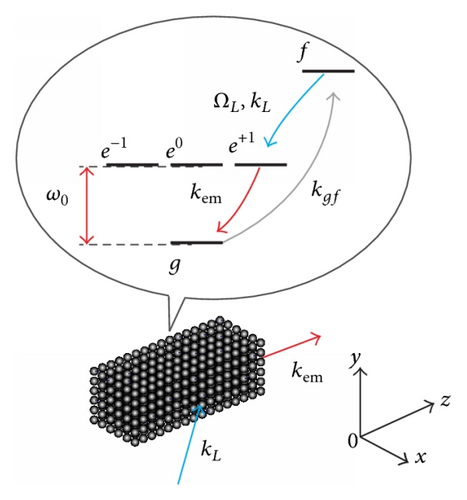
To simplify the model, we henceforth ignore spontaneous emission on the e-f transition; this may on the one hand be chosen as a transition with a weaker dipole moment, and on the other hand it does not experience the collective enhancement that we shall observe on the e-g transition. Further, we use rotating wave approximation in (34) because we assume strong laser light beam for this coupling, which allows treating this transition semiclassically.
Due to the collective effects the decay rate of the atomic sample can substantially deviate from the single atom decay rate. In the extreme case, depending on the geometry and the initial conditions, the collective decay rate can be vanishing. This behavior was coined subradiance. In the opposite case, when the collective decay rate is larger than the single atom decay rate, the behavior is called superradiance. These changes to the decay rate were pointed out by Dicke in early fifties in his pioneering work [103]. The collective effects have as well an effect on the spatial mode of the emitted light, which is substantially deviated from the single dipole emission pattern as well; see Figure 1.
The corresponding emission patterns for different atom configurations in a general case of interacting N atoms are presented in Figure 11. Due to the collective atomic effects the emission patterns are completely different from what we had for a single atom Figure 1. Precise calculations show [17] that, for the case of forward emission for atoms with larger separations, the role of the levels and on the photon reabsorption effects is negligible. The directionality of emission in this case depends on the lattice spacing and can be understood as interference of Bragg scattering contributions [43]. For a critical spacing of d = λ0/2 or an integer multiple of λ0/2 with λ0 = 2π/k0, the photon is mainly emitted in the forward and backward directions with equal probability; see Figures 11(a) and 11(e). With an increased value of d this symmetry is broken and the forward emission peak becomes dominant; see Figures 11(b)–11(d) and 11(f), which we approximately illustrated with (48) and (49). Due to the diffraction-like effects the directionality of the emitted light improves with the increase of the array size. This is illustrated on Figures 11(c), 11(g), and 11(h). They show the angular distribution of emitted light for lattices with the same spacing but with an increasing number of atoms.
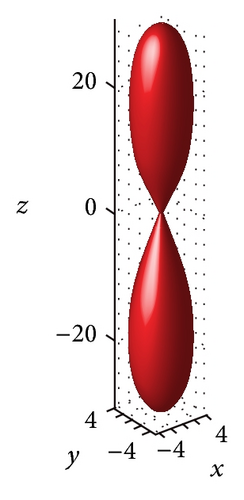
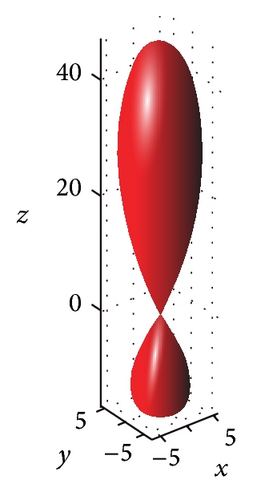
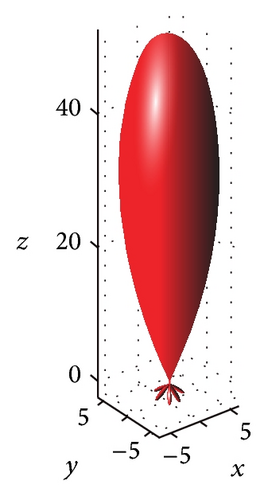
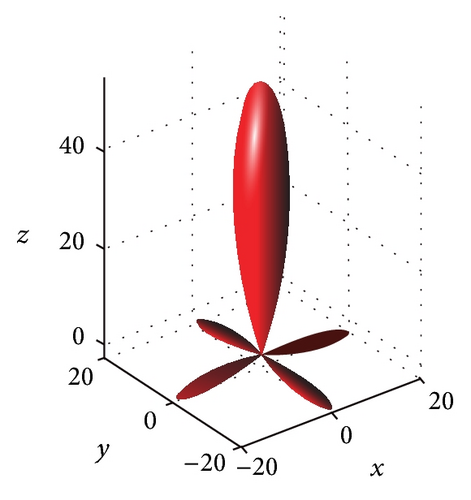
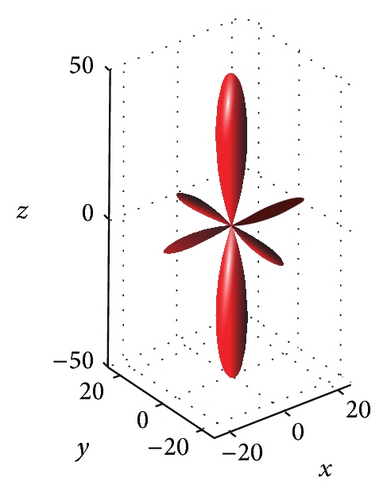
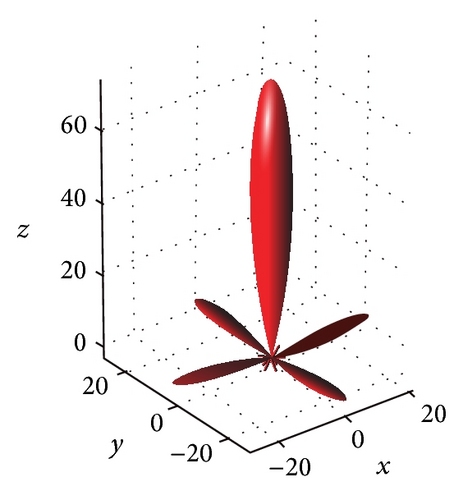

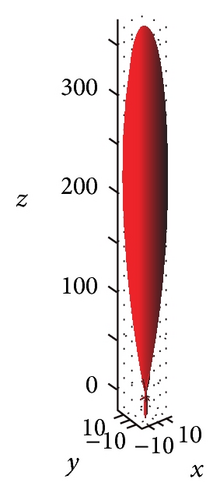
Therefore, in contrast to the single atom emission, the atomic array emission pattern can be tuned. In particular it can have very pronounced directionality already for a relatively small atomic array as depicted in Figure 11. Moreover, the analysis shows that in the forward direction mostly one polarization is emitted [17]. The light from this small solid angle can be efficiently collected by an objective with a reasonably small numerical aperture and straightforwardly converted to a propagating Gaussian light mode. This photon field can then be efficiently transferred over a large distance. Using a second objective this photon light can be matched to the spatial light field mode of a remote atomic sample, which then will absorb this photon, provided that the temporal modes are matched as well.
We proceed therefore now with the temporal mode of the emitted light. In the previous example we have assumed that the state |f〉 is coupled to |e+1〉 by switching on the constant laser field described by the Rabi frequency ΩL; see dashed red line on Figure 12. In this case the temporal profile of the emitted light is presented by a dashed blue line on Figure 12. It has approximately exponential shape. Its time constant is given by the combination of the coupling field parameters; see [17] for a detailed discussion of this shape. Modulation of the coupling field ΩL allows altering this exponential shape. For example, with the coupling field presented by a red line on Figure 12, the emitted light has a symmetric Gaussian temporal profile as shown by a blue line on Figure 12 [17]. Again, based on the time reversal argument [24, 30], the target atomic sample will fully absorb such incoming photon, provided that ΩL(t) coupling its |e+1〉 and |f〉 levels is properly timed.
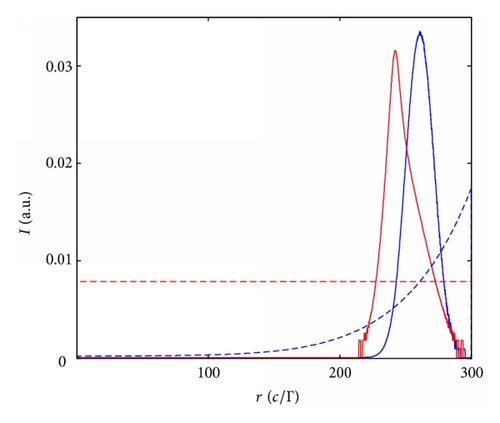
3.1.2. Experimental Techniques
The starting point of our theoretical analysis of the superradiance effects was a small ensemble of N identical atoms situated at certain positions in space. In particular, each atom should be localized at one point which is space and emitting without any recoil according to the initial Hamiltonian Equation (35). Practically, such system can be a sample of cold alkali, alkaline-earth, or rare-earth atoms arranged in a 3D array. Such arrays, for example, with rubidium, strontium, or ytterbium atoms, can now be routinely created using standing waves of counterpropagating laser beams or more generally in 3D optical lattices. Typical spacings in these arrays range from half the optical wavelength and upwards for red detuned traps. Therefore they readily satisfy the requirements for directional emission even for small atomic samples according to the analysis from Section 3.1.
The starting point for preparing such atomic samples is a Doppler cooling in a magneto-optical trap and transferring these atoms into a dipole trap, described in Section 2.2. Instead of taking a single focused laser beam for a single optical tweezer, one can create a 3D lattice of microtraps by using corresponding interference patterns of the trapping beams. Two counterpropagating beams will create a one-dimensional lattice of microoptical traps separated by half of the wavelength of the laser light. Six counterpropagating beams will correspondingly produce a 3D optical lattice with the spacing of half of the wavelength of the laser light. Changing the intensity of the laser beams, one varies the depth of the microoptical traps [52].
Although efficient reloading of cold atomic clouds from a magneto-optical trap to an optical lattice is possible [121, 122], the individual lattice sites are filled with a random number of atoms. These atom number fluctuations can be reduced to zero or one atom per site at most using the effect of collisional blockade, described in Section 2.2.1. Furthermore, collisional blockade schemes can be used to reduce the number of multiply occupied trapping sites for atoms stored in a 3D optical lattice [123]. For the experimental realization of the situation described in Section 3.1 we need a lattice with single atom per a trapping lattice cite. A widely used route towards reaching unit occupation per lattice site is first to cool the atomic sample down to reach a superfluid Bose Einstein condensation state. This ultracold atomic sample is then adiabatically transferred into a 3D optical lattice. A close to perfect array of atoms is then obtained with almost exactly one atom per site by inducing the Mott insulator state increasing the barrier between the trapping sites of the lattice [124, 125]. Arrays of atoms with given dimensions can be prepared by removing the unnecessary atoms [126]. Such arrays of ultracold atoms are perfect candidates for demonstrating collective atomic effects.
The collective interaction effects in such an array of atoms have two distinct experimental signatures. The first one is the change of the decay rate of the atomic sample, relative to the single atom case or an array of noninteracting atoms. Depending of the initial excitation state of the atomic array it can be faster (superradiance) or slower (subradiance) or it can have nonexponential behavior in the form of beats of several modes [17]. The second experimental signature is the change of the directionality of the emission-absorption patterns of the atomic sample, relative to the single atom case. The temporal signature of the collective interaction is present already for two particles. In this geometry the effects of super- and subradiance were already observed with two ions [127] and two molecules [128]. Nanothickness atomic vapors were used to spectroscopically observe the temporal collective effects [129]. Here the collective interaction between the atoms has an effect on the light transmission through the atomic sample. The change of spatial directionality of the emission-absorption patterns is observable with multiatom systems. The current experimental efforts and the corresponding theoretical proposals are directed in detecting both of these signatures of collective interactions effects. Due to the very challenging nature of these experiments, where an atomic array of cold atoms has to be created and coherent properties of these atoms have to be controlled in one setup, the main work is currently performed with dense ultracold clouds of atoms [119, 130–132], instead of regular arrays; see Section 3.1.1.
3.2. Rydberg Blockade
3.2.1. Modelling Rydberg Blockade
So far in Section 3.1.1 we have assumed that the system on N atoms possesses only one excitation. In this section we look into the question how this situation can be practically realized.
Neutral atoms in a ground state trapped in an optical lattice with the spacing of the order of the emission wavelength interact weakly. Therefore, an excitation of the atomic sample with one common laser beam from the ground state |g〉 to the state |f〉 will bring all the atoms into this state, resulting in many excitations in the atomic system. In contrast, if the atoms are in a highly excited state, that is, Rydberg state, the interatomic interactions at these separation are much stronger due to large dipole moments of these states. The extension of the electron wave function for the last valence electron of the atom increases as n2a0, where a0 is a Bohr radius and n is the principle quantum number. This scaling results in large dipole moments for atoms in high n-states, that is, Rydberg states, for they are proportional to the extension of the valence electron wave function. Consequently, if several quantum systems interact strongly with each other, their simultaneous excitation by the same driving pulse may be forbidden [133–135]. This effect is known as Rydberg blockade and the range where the full blockade takes place is called blockade radius.
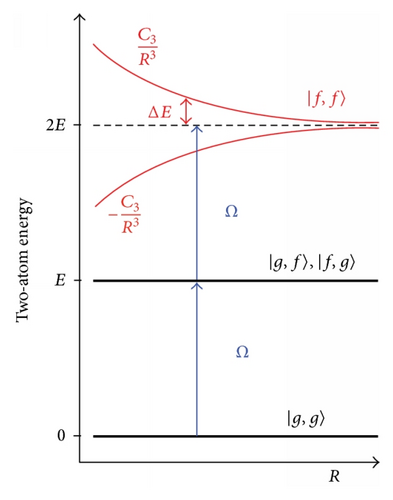
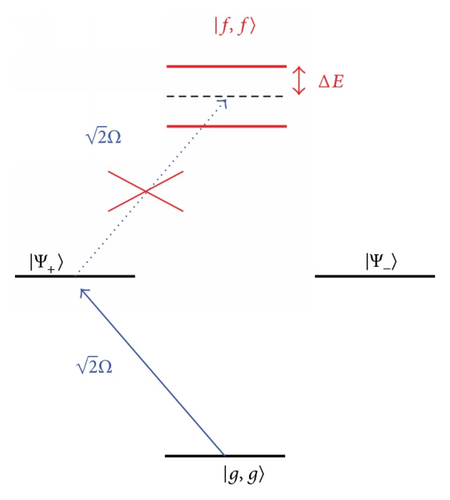
3.2.2. Experimental Techniques
The first distinct signature of Rydberg blockade in the atomic system is the saturation of the number of the atoms excited to the Rydberg state. The early study focused on studying this effect in clouds of cold atoms [137–142] as well as in a Bose condensate [143, 144]. The second signature of Rydberg blockade is the coherent collective behavior of the many-atoms system as an effective two-level atom, which was observed for two or a small controlled number of atoms [134, 135, 145–147].
The technical design of each of these experiments is unique; nevertheless there are certain experimental steps, which are common to all experiments: few atoms trapping, Rydberg excitation, and state detection. To illustrate these steps, we look in more detail onto the experiment from [134], which is conceptually the simplest and closely corresponds to the theoretical model from Section 3.2.1. In this experiment two 87Rb atoms are trapped at a controlled separation and excited to a Rydberg state. The experiments starts with the overlappring of a MOT of 87Rb with a two tightly focused laser beams for two optical tweezers; see Section 2.2.1. Due to the process of collisional blockade, exactly one atom is loaded into the conservative potential of each of the optical tweezers. Due to the presence of the cooling beams of the MOT, the fluorescence from the atoms in the optical tweezers is continuously collected and observed. The Rydberg excitation step starts, if both traps are loaded with a single atom. After a short Doppler cooling, the atoms are optically pumped to the |g〉 state S1/2 | F = 2, mF = 2〉 by sending two laser beams: σ+-polarized light resonant with the atomic transition S1/2 | F = 2〉 to P3/2 | F = 2〉 (taking into account the light shift of the ground state) and repumping light resonant with the transition S1/2 | F = 1〉 to P3/2 | F = 2〉 for 600 μs. To ensure that there is no population left in the S1/2 | F = 1〉 ground state, the repumping light is switched off 1 μs later than the pumping light. The excitation from this |g〉 state to the Rydberg state |f〉58d3/2 | F = 3, mF = 3〉 is performed using a two-photon transition through the intermediate state 5P1/2 | F = 2, mF = 2〉 with the detuning Δ/2π = 400 MHz [148]; see Figure 14. This large detuning from the intermediate state is chosen to avoid population in the intermediate state. A two-photon excitation to the Rydberg state |f〉 using infrared and blue laser light is technically more practical in the case 87Rb than a direct excitation to the Rydberg state |f〉, which requires a tunable ultraviolet laser. Using zero two-photon detuning δ and varying the duration of the excitation pulse, both atoms are coherently driven between the ground state |g〉 and the respective Rydberg states |f〉. The population in the Rydberg state after each excitation pulse is measured by photo ionizing Rydberg atoms and checking the presence of the atom in the trap afterwards [134, 148]. If the separation between the atoms is larger than the Rydberg blockade radius, both atoms independently undergo coherent Rabi oscillations between the respective states |g〉 and |f〉; see Figure 15(a). In contrast, when the distance between the atoms is smaller than the Rydberg blockade radius, the coherent excitation of both atoms simultaneously to the respective Rydberg states is greatly reduced due to the Rydberg blockade; see the black triangles on Figure 15(b). Correspondingly, these two atoms with the separation of 3.5 μm undergo full Rydberg blockade and possess maximum one excitation in the Rydberg state [134]. A recent experiment in a group of Barredo and collaborators demonstrated this effect with three trapped atoms [147]. In order to retain the condition of full blockade during scaling up the number of atoms the distance between the furthest atoms in the system should be smaller than the Rydberg blockade radius.
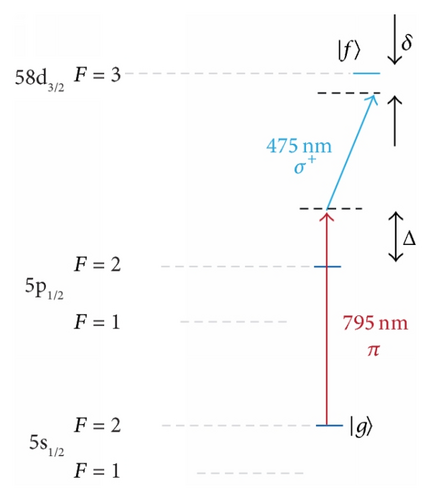
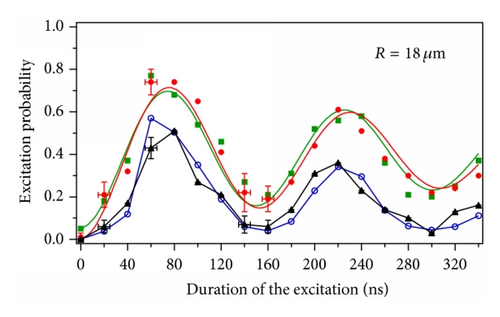
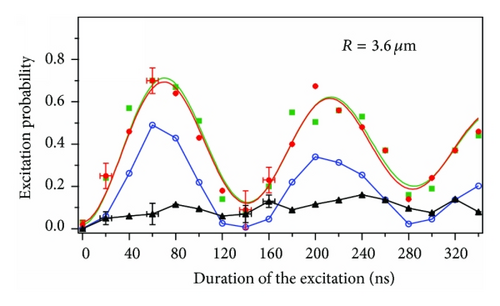
3.3. More than Usual Atoms
In the previous section we have outlined the idea of utilizing an ensemble of atoms for collective emission and absorption of photons in a highly directional way. In this system the directionality is due to the superradiance-like effect between the collectively emitting atoms. At the same time, under the condition of Rydberg blockade, there is only one atomic excitation in the system. Therefore such atomic array behaves effectively as a “superatom” with one excitation but highly directional emission-absorption profiles. So far we focused at the properties of such “superatoms,” that make them more tunable and experimentally flexible, relative to a single atom. In contrast to a single atom, a “superatom” has unique properties, which are not present in the single atom at all.
3.3.1. Deterministic Single Photon Subtraction from Arbitrary Light Fields
We consider an array of N atoms in the Rydberg blockade regime. We look at the effect of this atomic ensemble onto a laser, which coherently drives excitations to the Rydberg state on the g-f transition. The coherent interaction of the “superatom” with this light field is described by (53). The system performs Rabi oscillations between the ground state |g〉 and the single bright state |Ψ+〉 with the collective Rabi frequency [136]. This is the only bright state out of N orthogonal states of this N atom system. The other N − 1 states are decoupled from this interaction and are dark. This is the system we have considered so far in Section 3.2.1.
Deliberately adding to this system an extra coupling between the bright and the dark states radically changes the behavior of this system. This extra coupling should be a quick dephasing mechanism, for example, using speckles of a detuned laser beam, which produces random extra light shifts at the positions of different atoms [136]. If this dephasing is faster than the Rabi oscillations, this mechanism interrupts the coherent Rabi oscillations between the states |g〉 and |Ψ+〉. As far as there is one atomic excitation in the system, it gets quickly spread out between the dark states and distribute the excited state population over all N states; see Figure 16. Since the dark states are themself some superpositions with the Rydberg states, the atomic system remains in the Rydberg blockaded regime. For large number of atoms in the system, the population of the bright state is dramatically reduced. This atomic system gets exactly one excitation and is afterwards almost completely decoupled from the excitation laser light Ωgf. From the practical point of view this mechanism removes one photon from the laser excitation beam with the probability N/(N + 1), which can be almost unity for large number N of atoms [136].
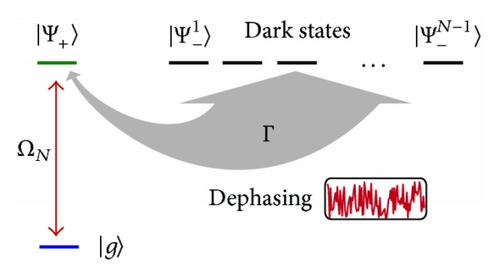
So does this mechanism of photon subtraction work with a single atom or do we necessarily need a “superatom” (i.e., an ensemble of N atoms under the full Rydberg blockade)? The only physical requirement for the mechanism to work is that the atom has the proper level structure. We need an excited state corresponding to the bright state |Ψ+〉 and a series of dark states decoupled from the direct laser excitation. The bright state might be a usual excited state coupled by a dipole transition from a ground state with Ωgf, and the dark states are a series of metastable states not directly coupled to the ground state absolutely analogous to the level structure on Figure 16. If the decay rate from the bright state to the metastable states is higher than the coupling Rabi frequency, a similar effect of trapping one excitation in a dark metastable state takes place. Therefore, single photon subtraction should be possible in this case as well. As an example of such level structure we consider a single 40Ca ion. It has four metastable states D3/2 (see Figure 5) which are coupled by spontaneous decay to the excited state P1/2 with the decay time to this metastable state of 90 ns [149]. So by driving the S1/2 (|g〉) to P1/2 (|Ψ+〉) transition with the coupling Ωgf slow enough the single photon subtraction mechanism can in principle work even with a single atom, although some modification due to the spontaneous decay to the ground state are to be expected. A similar level structure is present as well in alkaline-earth atoms (Sr) and rare-earth (Yb); see Section 2.2.1. The two apparent disadvantages of using single atoms are the following: there are relatively few metastable states, resulting in a reduced probability of a single photon subtraction. The cross section of one atom absorbing a photon is small, resulting in usability of this photon subtraction method only for intense light beams. In contrast gas of Rydberg atoms can have enough optical density to make the absorbing process more efficient. Moreover, the array of interacting Rydberg atoms automatically has the appropriate level structure made of many simple (two-level) atoms. This level structure of the “superatoms” can in principle be engineered at will.
This application of the “superatom” idea relies on the Rydberg blockade mechanism and a quick disposal of the atomic excitation form the bright state to the dark states. In principle, an ensemble of two-level atoms is enough for the realization of this photon subtraction protocol. Allowing for a more reaching atomic level structure opens a new avenue for even more sophisticated applications.
3.3.2. Atomic Ensembles as Quantum Registers for Improved Communication
Practical implementation of quantum communication with high fidelity is a challenging task due to the imperfections in realization of each step. Reference [150] introduced an idea of entanglement pumping, which should allow quantum communication between remote quantum registers with arbitrary high fidelity. One of the important ingredients of the algorithm is a possibility to perform quantum operations on the individual qubits of the small atomic registers [150]. The original algorithm is based on probabilistic photon absorption by two remote registers. Using “superatoms” as individual quantum registers allows performing deterministic emission and absorption of single photons; see Section 3.1, therefore making the algorithm faster [117] by eliminating the need for waiting for the coincidence detection in the original proposal [150]. Moreover, “superatoms” allow for alternative qubits encoding in a register. Typically individual qubits of a quantum registers are encoded in single atoms [4, 79, 151]. For small atomic arrays that we consider here, individual addressing of these qubits is a challenging task, since the separations between individual atoms are less than a wavelength of the exciting light; see [151] and references therein. An alternative approach is to use a collective qubit encoding method [152]. This encoding method allows as well to perform one- and two-qubit operations utilizing the mechanism of Rydberg blockade (see Section 3.2) without the need for individual atom addressing. Therefore we sketch now briefly the necessary atomic level configuration, which we can use to combine directed emission-absorption together and with the collective encoding and operations on the register qubits.
The introduced atomic level structure (see Figure 10) is enough for realizing the directional emission-absorption due to the superradiance effects as well as for the Rydberg blockade mechanism. Extending the level structure of individual atoms of the ensemble with metastable levels |c〉, |a1〉, |a2〉, |a3〉, and |s〉 (see Figure 17) allows encoding five qubits on this atomic ensemble consisting of N atoms. The blockade radius in the Rydberg states |f〉 and |fI〉 is larger than the extension of the atomic ensemble.
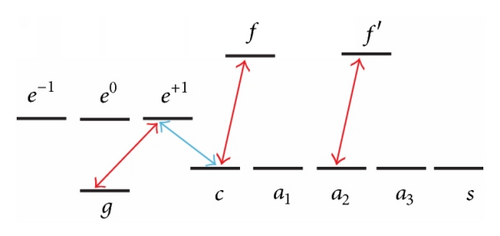
Using this level structure, the conventional register state with five qubits |c, a1, a2, a3, s〉 = |0,1, 1,0, 1〉, meaning the atomic qubit c is in the state |0〉, qubit a1 is in the state |1〉, and so forth, corresponds to the N-atom ensemble encoding with one excitation in the state |a1〉, one in |a2〉 and one atomic excitation in |s〉; see Figure 18(a). With this encoding there is a direct correspondence between the binary representation of a register state and the Fock state representation. In contrast to the conventional individual atom register encoding, where a single qubit rotation is performed in one step by directly addressing the qubit transition of the corresponding atom, the collective register encoding requires three steps. For example, to flip the state of the qubit a1 we have to first drive a π-Rabi pulse from the state |a1〉 to the state |f〉. Then we apply a π-Rabi pulse between |g〉 and |f〉. Finally, another π-Rabi pulse from the state |f〉 to the state |a1〉; see Figure 18(b). If the system has one excitation in the state |a1〉, it will be transferred to the Rydberg state |f〉. During the second step one excitation from the |f〉 state will be transferred to the ground state |g〉. The final step will have no effect, for there is no population in the Rydberg state |f〉. In contrast, applying the same sequence of pulses to the state |a3〉, nothing will happen during the first step. On the second step, due to the Rydberg blockade, exactly one excitation will be transferred to the state |f〉. The final third step maps this population onto the state |a3〉, therefore flipping the qubit state of this qubit [117, 152, 153].

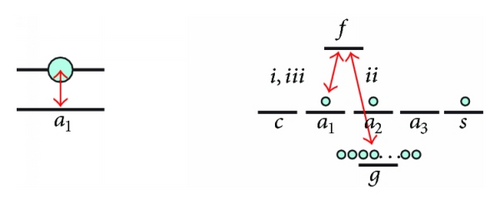
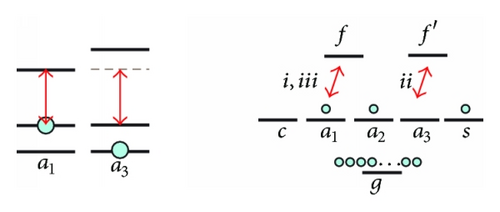
In the collective encoding scheme the conditional two-qubit gate between |a1〉 and |a3〉 is performed in three following steps: first, a π-Rabi rotation pulse between the states |a1〉 and a Rydberg state |f〉. This is followed by a 2π-Rabi pulse between the target qubit state |a3〉 and another Rydberg state |fI〉. Finally, the gate is finished by performing a π-Rabi rotation pulse between the states |a1〉 and a Rydberg state |f〉 [117, 152, 153]; see Figure 18(c).
The collective encoding method can readily be implemented using cold Cs atoms [152, 153]. Cs atoms have enough metastable states for the register encoding. Therefore already a small array of these atoms can be used as a quantum register with the possibility to perform quantum local operations on the qubits in order to realize entanglement pumping [150]. A register with many more qubits seems to be experimentally feasible as well, if we switch from Cs to atoms with even more metastable, for example, using Ho atoms [154].
3.4. Conclusions
In this section we formulated the problem of efficient interfacing single photons and small atomic ensembles. A properly engineered multiatomic ensemble can behave as a “superatom,” that is, having only one atomic excitation and a tunable emission-absorption pattern. This possibility of directly tuning the emission pattern eliminates the need for an extra mode converter, which was critical for the efficient interfacing of a single-atom with a single photon. The techniques for controlling temporal emission patterns, developed for single atoms (see Section 2) can be directly applied to the “superatoms” as well. Throughout the section, parallel to the theoretical formulation of the main theoretical concepts, that is, superradiance-like effects and Rydberg blockade, we presented the state-of-the-art of experimental techniques for the realization of these theoretical ideas.
Since a multiatom ensemble has intrinsically more degrees of freedom than a single atom system, properly utilized, these degrees of freedom can be used for more sophisticated applications. We went through several such examples, such as single photon subtraction from an arbitrary light fields and quantum computation within an atomic ensemble for improved quantum communication.
4. Outlook
We have considered two complementary approaches for single photon-atom interfacing in free space. In principle, all the necessary experimental techniques have already been experimentally demonstrated in different laboratories.
Atom cooling and trapping now became a routine task in many modern quantum optics laboratories. Even the techniques for trapping single atomic ions or neutral atoms are now well understood and can be implemented very efficiently. The key ingredient for single atom-photon efficient interfacing is the dipole emission mode converter; see Section 2.1.2. Such highly efficient conversion of the dipole emission pattern from a single atom to a Gaussian light mode is currently theoretically well understood. The challenging step is the integration of a trap for single atoms into the converter and reaching near unity overall process efficiency in a scalable manner.
Techniques for preparing 3D arrays of cold neutral single atoms based on Mott insulator state are reliably used in many laboratories. The route towards the Mott insulator state starts with laser cooled atoms, which are then additionally cooled in a Bose Einstein condensate. Then the atomic condensate is adiabatically transferred into the optical lattice with the necessary spacing. Finally, the arrays of atoms with given dimensions should be prepared by removing the unnecessary layers of atoms [126]. Such atomic arrays in combination with the Rydberg blockade mechanism can be then used as “superatoms.” The challenging step is the creation of such atomic arrays itself. Whether the theoretically explored array geometry of ultracold atoms is experimentally the easiest one or some other configurations, for example, thermal atoms trapped inside microcells [155] or a hollow core fiber [156], will prove to be experimentally easier to realize and use? This question is open to studies and has to be approached at the same time theoretically and experimentally.
Both for single atoms and “superatom” approaches, the biggest challenge is to combine the necessary techniques in one reliable and scalable experimental setup. Therefore the main question is which approach will give practically the most reliable and the highest efficiency of quantum communication. The versatility of the “superatom” idea offers applications even beyond the single atom-single photon quantum communication protocol. Therefore we can expect even more surprising applications with this quantum system.
Conflict of Interests
The author declares that there is no conflict of interests regarding the publication of this paper.




